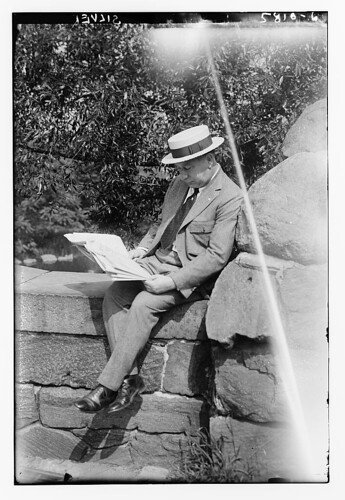
You just want the full 65-page PDF? It’s here:
The GMAT Reading Comprehension GuideYou Don’t Read Fast Enough for the GMAT
That’s not a value judgment or insult; that’s a statement of fact.
Top scorers in Verbal simply read more quickly. The people who roll the Verbal section up and smoke it? Usually finished in 60-65 minutes out of the total 75.
What makes the difference for them? Simple. They read more quickly.
But How am I Going to Learn to Read Faster?
That’s a valid question, and quite honestly I can’t teach someone how to read properly. Fast readers tend to get fast through years of training and learning their own shortcuts.
I’m not talking about champion-level speed reading here. I’m just talking solid, grad-school researcher-level reading: approximately 450-600 words per minute.
In the end, I can’t force someone to read but I can give some advice. The horse might die of thirst, but I can assure you that I did drag his ass over to the river.
I Could Never Read That Fast!
Do you want the good news first? Yes, you can. It’s not as hard as it seems.
Do you want the bad news now?
Nope? You’re getting it anyway: you’re going to have to practice your ass off to achieve this.
Basically, a lot of people don’t like to read and don’t do it enough. No judgment, just fact. If you think I’m talking about you, 1) get over yourself and 2) pick up a fucking book.
You’ll need to spend time reading. Not really paying a huge amount of attention to what, except that it needs to be accessible and at a reasonable level of difficulty.
My recommendations would be Scientific American and The Economist. These publications tend to have a reading level more or less on par with the GMAT.
Get copies as often as you can and read them.
Change your phone’s wallpaper so that when you grab the phone and start working out your stubby little thumbs you see this message:
JUST GO BLOODY READ AN ACTUAL THING AND QUIT CHECKING FACETOK, INSTACHAT, AND TWATTER AND THE GMAT WILL THANK YOU
Get your magazines. Love your magazines. Read them on the train. Read them in the car (assuming you’re not driving). Read them in the shower, for all I care. Just read whenever you have a moment.
God forbid, you might actually learn something in the process.
Applicable Strategies for GMAT Reading Comprehension
So you want to learn to read faster…
There are things to do. Remember how you’re supposed to read the stuff I told you to? Apply these principles whenever you do.
The more you read, the more practice you’ll get. Unsurprisingly, the better you’ll do on GMAT Verbal.
How to Read for the GMAT and Life
Strange as it might seem to suggest learning a totally different way to read, many people really do have problems with the density of material on the GMAT.
It’s not just reading passages: the faster you can break down the important parts of a sentence or an argument the better you’ll get at Sentence Correction and Critical Reasoning, respectively.
However, let’s focus on Reading Comprehension because that’s the most obvious place to apply this knowledge.
GMAT Reading Comprehension is Meant to be Confusing
I mean… duh.
The passages are intentionally written using language and structure that is non-standard. They are designed to be hopelessly dense and confusing on the sentence level.
If you spend too much time trying to read for the details of the passage, you’ll simply find yourself mired in the details.
The solution to this problem is very counter-intuitive: go faster.
In fact, that is almost always the answer to how to proceed in GMAT Reading Comprehension—just read faster—and by that I do in fact mean “take in less information.”
The GMAT Reading Comprehension GuideHow in the Everloving Hell is That Helpful?
Structure, Not Content. Please.
If you’re getting too focused on the irrelevant details it’s very difficult to see the larger structure. What you’ll find is that many of the questions (up to 80% of them) will be based on structure and the specific details of the passage are totally irrelevant for these questions.
In fact, a colleague of mine—a fine GMAT instructor—swears that anyone with the proper training can read a GMAT RC passage in 30 seconds and get 80% of the questions correct! The point of this is not dick-waving, but rather to highlight that structure is the only thing that can possibly be gleaned in this 30-second window.
Imagine: if you got 80% of the RC questions right, you could even forget about the detail questions and still get a great Verbal score!
GMAT Reading Comprehension Means “Read with Less Care”
As a general rule, the Reading Comprehension section of the GMAT—again counter-intuitively—requires the least care to read. That is, fine-toothed, detail-oriented reading.
In terms of detail-oriented “care reading”: read Data Sufficiency questions with the most care, then Problem Solving, then Sentence Correction, then Critical Reasoning, and only then Reading Comprehension.
Reading for Structure
However, if you’re reading only for the general structure of the passage, you’ll find that you actually can read the passages in 30 seconds to two minutes.
But What About the Details?
Remember that the passage is always sitting right there in front of you. You can refer back to it if you encounter a detail question.
In fact, because the passages are written in this intentionally obtuse, confusing language, you actually stand a better chance of understanding the gross structure of the passage when you read it at a pretty fast clip.
It’s just like quicksand: if you don’t want to sink, run quickly across the surface.
If not, well, tell me what you find down there.
You Can Force Yourself to Read Faster
You want something objective to do? Here you go.
Find a utensil: a pen, pencil, box-knife, or finger (please don’t take a box-knife to the Test Center). Run the utensil over the words as you read—just like a five-year-old. Yup.
But I’m a Grown-Up! I Don’t Need to Use My Finger While I Read!
And I’m sure you can tie your own shoes like a big boy, too. Do you want a cookie? Listen for a minute and you might learn something.
Take the utensil and follow its tip. This is important: follow the tip and NOT the words. Let your eyes relax and take the words in with a relaxed focus.
NEVER let the tip of the utensil drift back. This is how most us waste precious time while reading: our eyes drift back and read things multiple times. The worst part is that we don’t even realize that this is happening!
You’ll become painfully aware of this as you get better at reading while using a utensil. Be careful never to let yourself drift back.
Active Reading vs. Passive Reading
Reading with a utensil is the single most effective way to engage in what is called “Active Reading.” This is reading for a purpose: taking as much information in as possible.
It is contrasted with “Passive Reading,” or letting the words wash over us as if we were reading a Dan Brown novel on a beach.
Active Reading involves leaning forward, processing the information as we go along, blinking every so often (thereby allowing the brain to file information), and summarizing each main point as it is introduced.
Most often, this involves leaning forward and focusing.
The Scan/Skim Method
(Now–following on from the last section–before I have to remind you, pick up a pen or pencil and follow the text).
People who practice “proper” speed reading claim that even after a brief glance, all of the information on a page is stored somewhere within your unconscious mind.
“Reading” is simply allowing yourself to unlock and process this information.
It’s an interesting idea—maybe it’s true and maybe not. But let’s work from that assumption for a moment.
SCAN:
Try an initial read—a Scan—of your reading passage in no more than 30 seconds.
In order to do this most effectively, simply drag your utensil down the middle of the entire passage—as if you were vertically cutting the passage in two. As before, focus only on the tip of the utensil and don’t try to process the information.
SKIM:
Now go back to the passage and read it line-by-line with the utensil. Go just fast enough that it seems a little bit uncomfortable—as if you’re not getting as much information as you’d like—but get the basic gist of what you’re reading.
Based on the VERY general context you got from the initial Scan, this Skim will provide you with much more useful information.
Now go away and try a passage with SCAN.
Back already?
Now go away again and try a different passage with only SKIM.
See which technique you prefer. Does one seem to work better than the other? Stick with it.
See how much less information you take in. It really does seem to make less sense, doesn’t it?
Strange, but it works.
Still hate reading? This might well remind you of an uncomfortable truth.
In order to get good at GMAT Reading Comprehension, you’ll have to learn to enjoy it—even the math, even the reading, and even the fact that the test and testwriters are trying their damnedest to screw you over.
Luckily as human beings we are a very adaptable lot.
We can learn to love anything. Much as victims of Stockholm Syndrome begin to experience love for their captors, we must learn to love the GMAT.
Think about it like this:
Wimbledon champions or concert musicians don’t inherently love “tennis” or “the violin” as an abstract concept. Rather, these people were introduced to the sport or the instrument at a very young age.
They’ve been playing for so long that they don’t know anything else. More importantly, it’s not the abstract notion of what they do—there is no a “honor of well-played tennis” to anyone except an armchair fan.
Rather, these super-adepts do what they do almost unthinkingly, and they get addicted to minute improvements.
They learn to see little things that are wrong—little details that would be invisible to anyone else—and they spend their time working on improving these imperceptible things because they understand that this will give them the edge over the competition.
In short, the love is not “for the game,” but for the tiny, incremental improvements that can be made.
Even if you hate the GMAT as a concept—and believe me, I do more than most people—you can learn to love getting better at the GMAT.
The GMAT Reading Comprehension Guide